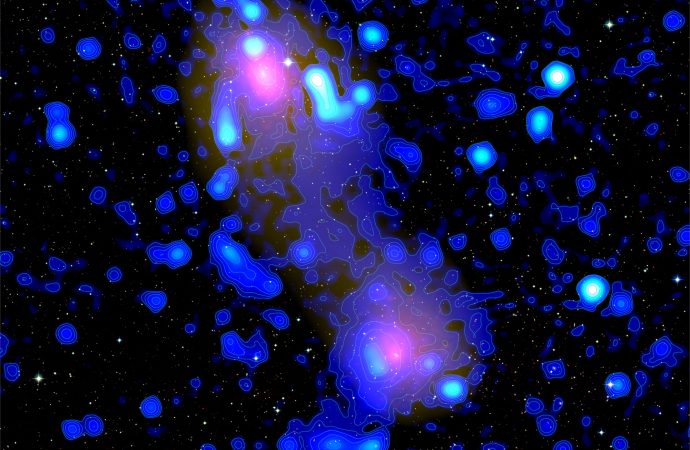Scientists predicted that our universe’s structure resembles a huge web. We’ve finally seen one of the strands.
Source: National Geographic
A billion light-years away, two galaxy clusters are slowly crashing into one another. Now, for the first time, observations have revealed a peculiar ridge of radio waves linking those clusters, like a thread strung between galactic beads.
This radio ridge stretches more than nine million light-years across and traces one of the filaments in the so-called cosmic web, the structure thought to describe the large-scale organization of the universe.
While astronomers have been able to see the myriad galaxies and galaxy clusters that make up the knots in this cosmic net, actually observing the threads between galaxies is not an easy feat. The new image, which shows a stream of plasma between the galaxy clusters Abell 0399 and Abell 0401, is the first known sighting of its kind.
“Radio emission connecting clusters has never been observed before,” says Federica Govoni of Italy’s National Institute for Astrophysics, who reports the observation today in the journal Science. But now that it has, the discovery may help astronomer better understand the universe on its grandest scale.
Dark threads
The cosmos is thought to be uniformly filigreed, with large empty voids set between knotty, twisted threads of galaxies and colossal groupings of galaxies parked where those threads intersect. Until now, astronomers have mostly observed this cosmic web’s beads, or clusters. These enormous clumps of galaxies, with members sometimes numbering in the thousands, are tied together by gravity.
Rife with hot gas, dense dark matter, and blazing stars, galaxy clusters are observable throughout the electromagnetic spectrum, meaning that astronomers can discern their features in visible, infrared, x-ray, gamma ray, and radio wavelengths; already, rare haloes of radio waves have been spotted in the cores of some clusters, including Abell 0399 and Abell 0401.
But the space between those clusters, called the intergalactic medium, is sparsely populated and dark. That makes it especially challenging to see anything so far, far away—the nearest large galaxy cluster outside of our own Local Group of galaxies and the neighboring Virgo cluster is 65 million light-years distant.
Still, Govoni and her colleagues recently decided to peer into the space separating Abell 0399 and Abell 0401. Earlier, the orbiting Planck observatory spotted what appeared to be a tendril of matter connecting the two beads, an observation that Govoni says piqued her curiosity and made her wonder whether magnetic fields might also extend beyond the clusters themselves.
Opening doors
Currently, these two clusters are in the initial stages of merging. About 9.8 million light-years apart, they are destined to collide and form a larger supercluster. For now, though, they’re busy stirring up and perturbing intergalactic space, hurling shockwaves, magnetic field lines, and particles into their shared void.
It’s the effects of those perturbations that Govoni and her team observed, using an array of radio telescopes in Europe called the Low-Frequency Array, or LOFAR, for short.
LOFAR detected radio waves emitted by electrons traveling at near light-speed; called synchrotron emission, these waves are produced by speeding electrons spiraling around magnetic fields. It’s likely that such radio ridges are common throughout the cosmic web, but they’re largely beyond the detection limits of today’s telescopes, Govoni says.
“The signal detected in this study is a factor of up to a hundred times brighter than some theoretical predictions for the emission from the synchrotron web,” says astronomer Tracy Clarke of the U.S. Naval Research Laboratory. “This is likely because it is enhanced in this region between these merging clusters.”
The ridge, which spans an immense distance, is now raising questions about how synchrotron emission can be produced over such a large area, as scientists aren’t yet sure how electrons can be perpetually accelerated to near light-speed over such vastness.
“This opens a whole new set of doors to begin exploring things like the particle distribution in the filaments, the magnetic field strength—and potentially its origin—as well as acceleration or reaccelerating processes at work within the filaments,” Clarke says.

































Leave a Comment
You must be logged in to post a comment.